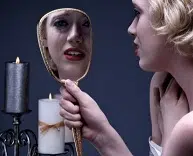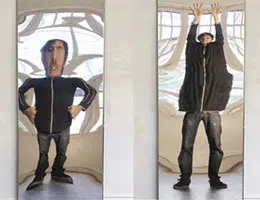 The concept of mirror , which comes from the Latin term specŭlum , refers to a surface that reflects what is in front of it. This is usually a glass board that is framed and hung on a wall.
The concept of mirror , which comes from the Latin term specŭlum , refers to a surface that reflects what is in front of it. This is usually a glass board that is framed and hung on a wall.
The change in the direction of a wave is called reflection , produced when, upon encountering a surface that separates two changing media, it returns to its place of origin. In the case of the traditional (flat) mirror, the light that is reflected from the surface converges at a point in space and the image that is "returned" is formed. This virtual image has the same shape and size as the real object, although it is inverted with respect to the normal axis.
Mirrors are usually placed in bathrooms and bedrooms of homes. In this way, people can groom themselves: comb their hair, put on makeup, etc. In clothing stores, mirrors allow customers to see how the clothes they try on fit on them.
These elements, on the other hand, are useful for viewing places that would otherwise be inaccessible to the eyes due to their location. Cars, for example, have rearview mirrors so that the driver can see what is happening behind him (that is, behind his own vehicle). In many stores, on the other hand, mirrors are installed that allow whoever is behind a counter to see different sectors of the business.
A similar example occurs in hair salons, where it is often necessary to use two or more mirrors so that the client can see the back of their head and appreciate the hairdresser's work. After a haircut that involves this area, it is normal for the professional to take a small mirror, place it behind the client and point it at the person in front of him, so that he can see his own neck.
 In short, the mirror is a very useful and versatile invention, since it allows us to get ready before going for a walk, verify the accuracy of a job we are doing or even protect ourselves from potential collisions while driving. But it can also be part of an obsession, for those people who have disorders related to their appearance .
In short, the mirror is a very useful and versatile invention, since it allows us to get ready before going for a walk, verify the accuracy of a job we are doing or even protect ourselves from potential collisions while driving. But it can also be part of an obsession, for those people who have disorders related to their appearance .
The problems with accepting one's own body are many and of varying intensity: from the concern about maintaining one's figure that comes with a very strict diet to body dysmorphic disorder (which leads the individual to perceive his or her own image in a very distorted way and to suffer from depression). , having a mirror on hand can sometimes be harmful. In these cases, it is essential to have someone to accompany the patient to help them face their crises, although many of them occur precisely due to the lack of a healthy reference.
Beyond the everyday usefulness of mirrors and the physical explanation of their operation, mirrors are objects that are linked to superstitions and myths . It is said that vampires do not reflect themselves in mirrors since the reflected image is the image of the soul , and these beings lack it. Different legends and literary works, meanwhile, take mirrors as doors to other worlds or windows to the universe of spirits .
This term can also be used to refer to the ability of any surface to reflect the images projected on it, either totally or partially. For example, if after cleaning and polishing a marble table it is impeccable, someone may say that "it looks like a mirror", although they do not really believe that but say it to congratulate the person who left it in that condition.
